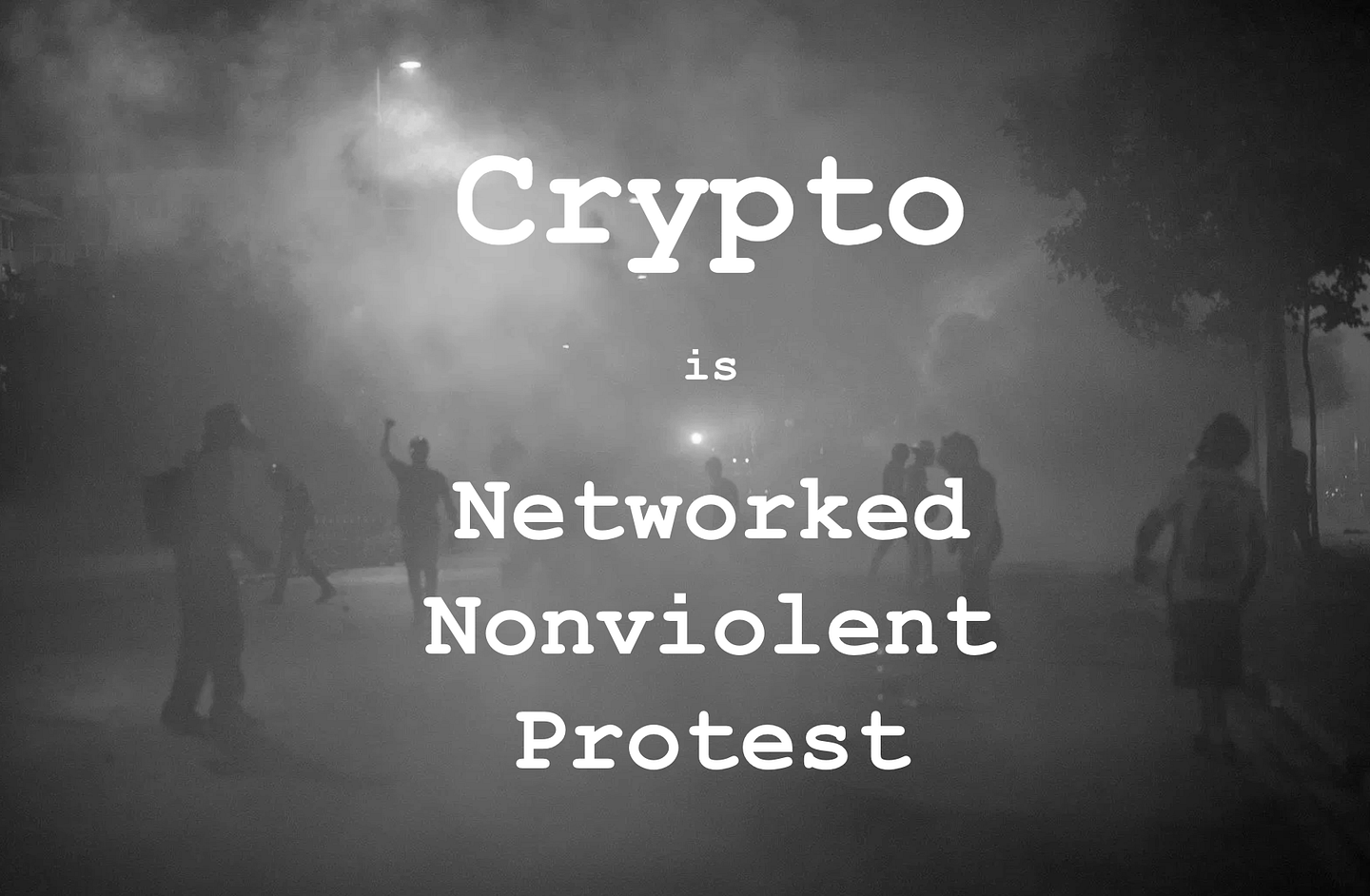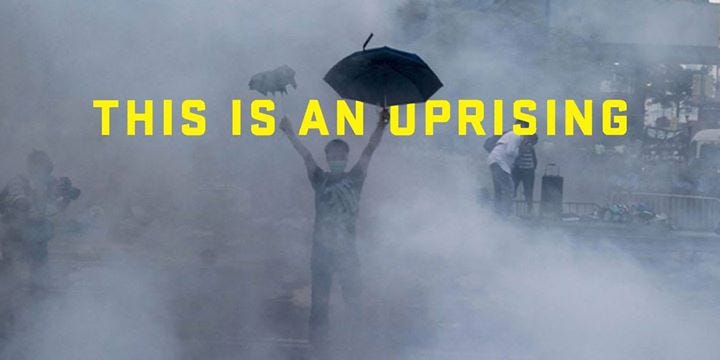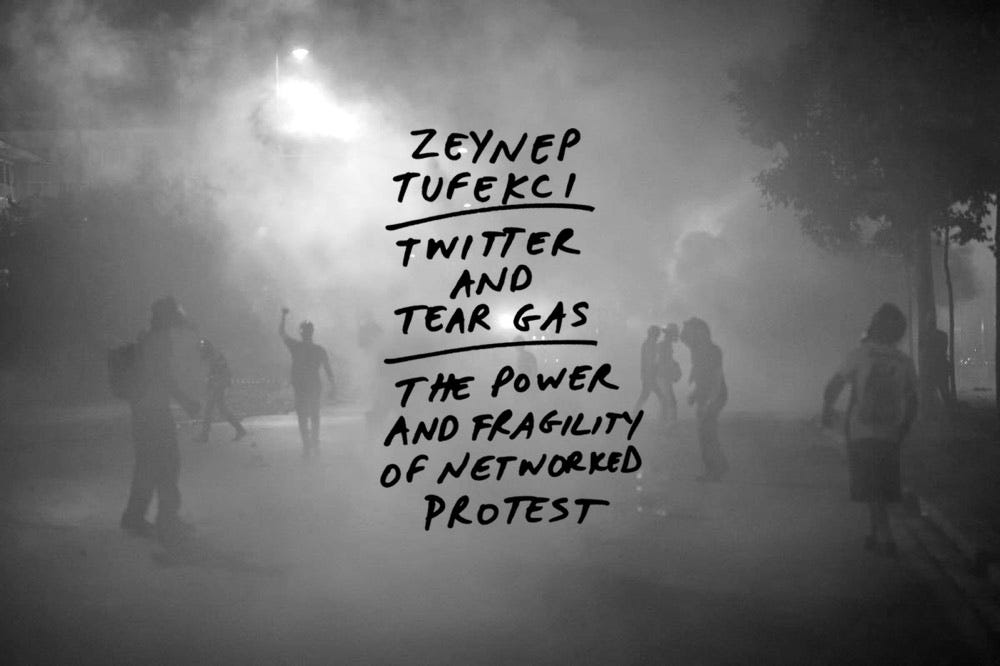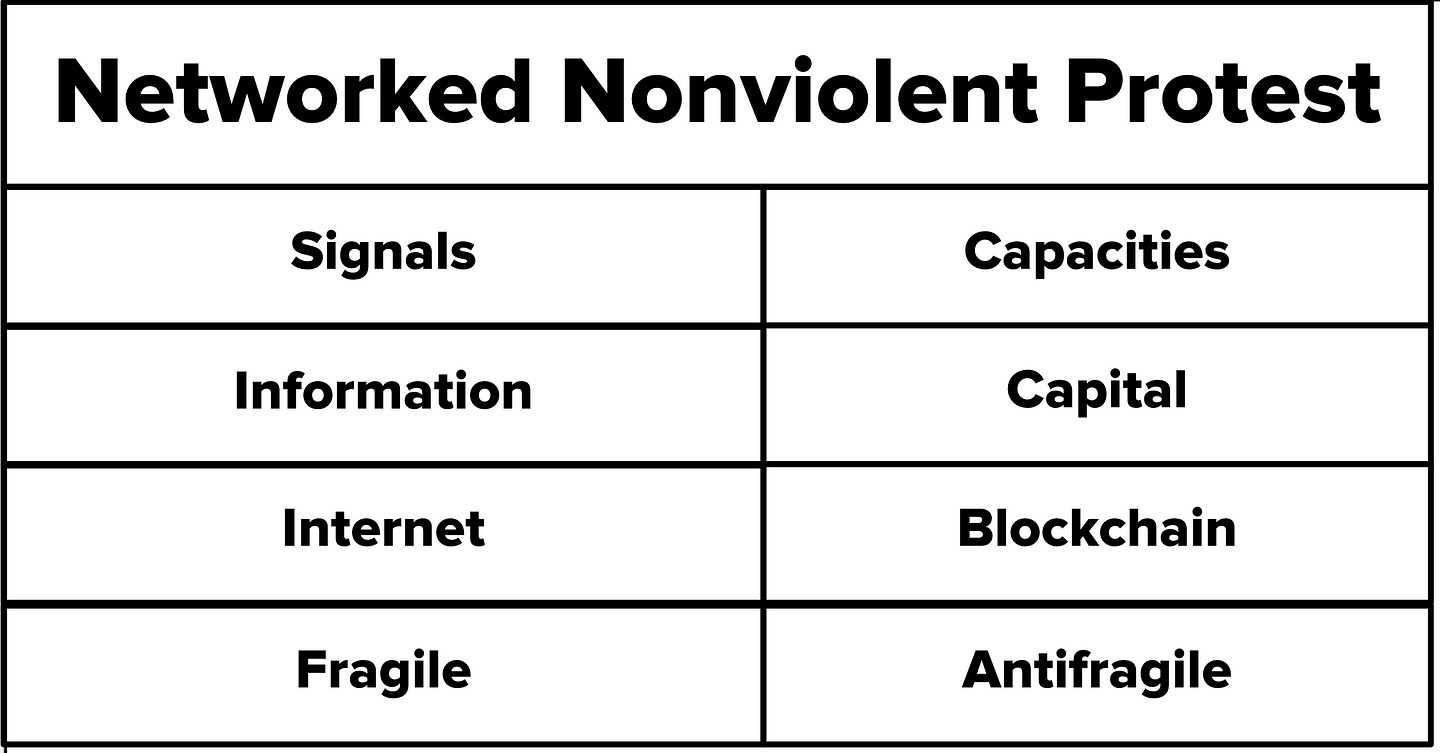Crypto is Networked Nonviolent Protest

“Technology rarely generates absolutely novel human behavior; rather, it changes the terrain on which such behavior takes place.”
— Zeynep Tufekci
The goal of this article is to explain how the internet (networked information) enabled fragile nonviolent protest, then map that onto how blockchain technology (networked capital) is enabling antifragile nonviolent protest.
We’ll do this by:
- Understanding nonviolent protest before the internet (using the book This Is An Uprising).
- Understanding nonviolent protest after the internet (using the book Twitter and Tear Gas).
- Predicting how blockchain will change nonviolent protest (using Vinay Gupta’s meta-structure framing).
Nonviolent Protest BEFORE the Internet
Before we dive into how the internet/blockchain changes nonviolent protest, let’s first understand nonviolent protest without digital technology. To do so, let’s do a quick overview of the book This is an Uprising by Mark Engler and Paul Engler. In it, they analyze how non-violent protest has shaped the 21st century.

The Power of Nonviolent Protest
First off, why would anyone actually want to use nonviolent protest? (Besides the obvious fact that nonviolence doesn’t led to physical suffering.) In fact, nonviolent protest is actually super effective. Professor Erica Chenoweth studied 323 protest campaigns and found that:
Nonviolent movements worldwide were twice as likely to succeed as violent ones.
In addition to this, she found that you didn’t need that much of the population for it to succeed. The breaking point wasn’t at 50%, it was at 3.5%:
“No campaigns failed once they’d achieved the active and sustained participation of just 3.5% of the population — and lots of them succeeded with far less than that.”
This is because the nonviolent protesters are using exit-like mechanisms to change the current system. To understand the reverse (the failure of violent protest), Engler writes:
The minute activists become violent, they enter onto the preferred terrain of the status quo, which is adept at outgunning its adversaries.
Short-Term Momentum, Long-Term Structure
Nonviolent protest is powerful, but how can organizers mobilize a successful movement? The answer lies in the crucial tension that all protests face. As a protest starts gaining momentum, they need to balance short-term momentum (like a big protest) with long-term capability building (like organizational logistics). Engler writes:
For as long as people have experimented with building movements around strategic nonviolence, they have grappled with a dilemma: how to reconcile the explosive short-term potential of disruptive power with the need to sustain resistance to meet long-term goals.
There’s a chain of goals: protesters want to create bursts of short-term momentum, use that to build capacity, then eventually create mass public change. Engler writes:
Because the long-term goal of a transformative movement is to shift public opinion on an issue, the first measure is whether a given campaign has won more popular support for a movement’s overall cause. The second measure is whether a campaign builds the capacity of the movement to escalate further.
We can look at this historically by looking at various protest movements. For example:
Sociologist Charles Payne has argued that the US civil rights movement consisted of two distinct strains of activity: one, which he calls the “community mobilizingtradition,” was a lineage “focused on large-scale, relatively short-term public events” such as the famous campaigns in Birmingham and Selma . This strain relied on the energy of mass protest. Payne contrasts this approach with the “community organizing tradition,” a structure-based lineage associated with the gradual base building and local leadership development carried out by the likes of legendary civil rights organizer Ella Baker.
To conclude: nonviolent protests can be incredibly effective. But to truly succeed, they need to balance short-term momentum with long-term capability building.
Nonviolent Protest AFTER the Internet
Now let’s transition to understanding how the internet changed nonviolent protest. To do this, let’s review Twitter and Tear Gas, by Zeynep Tufekci. The book analyzes the Arab Spring protests through the lens of “technology affordances”, i.e. how Facebook and Twitter enabled new kinds of networked protest.

Protests Have “Capacities” and “Signals”
Just like Engler does with “capabilities” vs. “momentum”, Tufekci breaks down a protests’ power into two categories—capacities and signals:
I had begun to think of social movements ’ abilities in terms of “capacities”—like the muscles one develops while exercising but could be used for other purposes like carrying groceries or walking long distances — and their repertoire of protest, like marches, rallies, and occupations as “signals” of those capacities.
Tufecki’s “capacities” map onto Engler’s “capabilities”, while “signals” map onto “momentum”. This distinction is especially crucial given the technological affordances of social networks. Tufekci continues:
The advantage of focusing on capacity rather than outcome is especially apparent in understanding the impact of digital technology on social movement trajectories. This is because seemingly similar outcomes and benchmarks — for example, a protest march attended by a hundred thousand people — do not necessarily signal the same underlying capacity to those in power when they are organized with the aid of digital technology.
In other words, we can’t look at outcomes in the same way. It is easier to organize a 100,000 person protest now than it was 50 years ago. Let’s reinforce this idea by using a different kind of technology as a parallel—transportation. If I told you I traveled 100 miles in one day (a signal), that would signal a different capacity at different points in “technological time”. If I said I traveled 100 miles pre-1700, you might be pretty amazed. (Did I travel by boat? A really fast horse?) But as we progress through time, I could’ve traveled 100 miles by train, car, or plane. The “pure outcome” (100 miles) signals different capacities given different technological affordances.
Social networks primarily allow for powerful signaling, but not necessarily as powerful capacity. In many ways, this is the crucial thesis of Tufekci’s book. She puts it in the title of the book itself—Twitter and Tear Gas: The Power(in signaling) and Fragility (in capacity) of Networked Protest. In the text itself, she writes:
In the past, organizing big protests required getting many people and organizations to plan together beforehand, which meant that decision-making structures had to exist in advance of the event, building the network internalities along the way. Now, big protests can take place first, organized by movements with modest decision-making structures.
This phenomenon, combined with the bottom-up/leaderless nature of protest, leads to a variety of issues for the protest itself:
I talk about what I call “ tactical freeze,” the inability of these movements to adjust tactics, negotiate demands, and push for tangible policy changes, something that grows out of the leaderless nature of these movements (“horizontalism”) and the way digital technologies strengthen their ability to form without much early planning, dealing with issues only as they come up , and by people who show up (“adhocracy”) .
To conclude: the internet drastically increased protesters’ ability to signal, but didn’t have a large increase on their underlying capacities.
Nonviolent Protest WITH Blockchain
So now we can address our final question—what technological affordances does blockchain technology give nonviolent protest? i.e. How will blockchain change nonviolent protest?
The key instinct here is based on the idea that [internet : information :: blockchain : capital]. We can then map Engler/Tufecki’s frameworks above onto information and capital. Signals are information-based. Capacities are capital-based. With this framing, it becomes clear that the internet’s information-based affordances primarily increased a movement’s signaling abilities (without really affecting their capacity). Again, this is reflected in the title of Tufecki’s book: Twitter and Tear Gas: The Power (in signaling) and Fragility (in capacity) of Networked Protest.
With “only” the internet, it’s difficult to take info-based signaling and convert it into capital-based capacity. But with blockchain-based community tokenization, we can essentially “link” info-based signaling to capital-based capacity (in a permissionless, networked way). This applies to the nonviolent protests described above, and to other info-based virality, like memes:
Right now memes convert info virality into capital leverage in "old" ways. (e.g. Starting an institution based on the meme.)
— Rhys Lindmark (@RhysLindmark) July 26, 2018
Once memes are coupled to capital (tokens) + governance, meme-based institutions will proliferate.
Imagine #metoo #MAGA #BLM, but with "native" leverage.
Blockchain Enables the Construction of Meta-Structures
In addition to the “networked information/value” perspective above, we can also understand crypto-based protest through Vinay Gupta’s presentation from Devcon1 (here’s his 10-minute video segment starting at 20:45). Vinay starts by describing the cypherpunk vision:
“Peer-to-peer communication will result in social structures that would rise to institutions.”
But as Tufecki has shown, info-based communication alone is not sufficient to create institutions. Vinay thinks this is because, “if there’s any complexity, you need core structures, meta-structures, on top of that structure.” But, unfortunately: “Cypherpunks had no good tools for meta-complexity.”
In other words, P2P communication didn’t result in institutions because info-based communication alone wasn’t able to fund the necessary meta-structures. Though not explicitly, Vinay is describing the same mechanism that Engler/Tufecki use for nonviolent protests—meta-structures are the capacities of nonviolent protests. The question then is—what are the funding mechanisms for these meta-structures? i.e. How does a protest build capacity?
This is where cryptocurrency-based capital comes in: as a technological affordance for “crypto protesters” to fund their meta-structures/capacities. Vinay claims that blockchain (and Ethereum specifically) is an “endless Swiss army chainsaw for building meta-structures.” With it we can:
Build complex social machinery in the form of meta-structures. That should pay for the public works necessary to build the rest of the machinery.
And, in the end, we build up blockchain-based institutions:
This is how we generate the staying power to get down the path and build what we all want: non-state public goods that fill humanity’s needs that the states have never been able to fulfill. In the long run, we’ll find more efficient ways to do a lot of the jobs that the state currently does so that we can leave the state to do the hard work that no one else seems to know how to do…but get it out of areas where it consistently underperforms.
In the end, this is creating competition over who supplies public goods—a market for sustaining the commons.

If you’d like to learn more about related topics (crypto as a bottom up movement), I’d recommend:
- Aragon’s Inspiring 5min Video: The Fight for Freedom
- Tony Sheng’s piece: Crypto and the Psychology of Mass Movements
- Mike Maples, Jr.’s piece: Crypto Commons
- My piece: Co-Evolving the Phase Shift to GameB
- Jeremy Heiman’s: New Power
Thanks to Collin Brown, Mike Goldin, John Desmond, Paras Chopra, Andrew Cochrane, Sandra Ro, Harry Lindmark, Jonny Dubowsky, Sam Jonas, Malcolm Ocean, Colin Wielga, Joe Urgo, Josh Nussbaum, John Lindmark, Garry Tan, Eric Tang, Jacob Zax, Doug King, Katie Powell, Mark Moore, Jonathan Isaac, Coury Ditch, Ref Lindmark, Mike Pratt, Jim Rutt, Jeff Snyder, Ryan X Charles, Chris Edmonds, Brayton Williams, Brian Crain, David Ernst, Ali Shanti, Patrick Walker, Ryan Martens, Kenji Williams, Craig Burel, Scott Levi, Matt Daley, Lawrence Lundy, Peter Rodgers, Alan Curtis, Kenzie Jacobs, and James Waugh for supporting me on Patreon! Thanks to Storecoin, Griff Green, Radar Relay, district0x, Niel de la Rouviere, Brady McKenna, and some anonymous others for supporting me on StakeTree! Thanks to KeepKey for sponsoring the show! Please use them/check them out!
Hit me up on Twitter!
Disclaimer: I own less than $5000 of any given cryptocurrency, so my monetary incentive is not too aligned with Bitcoin, Ethereum, etc. :)